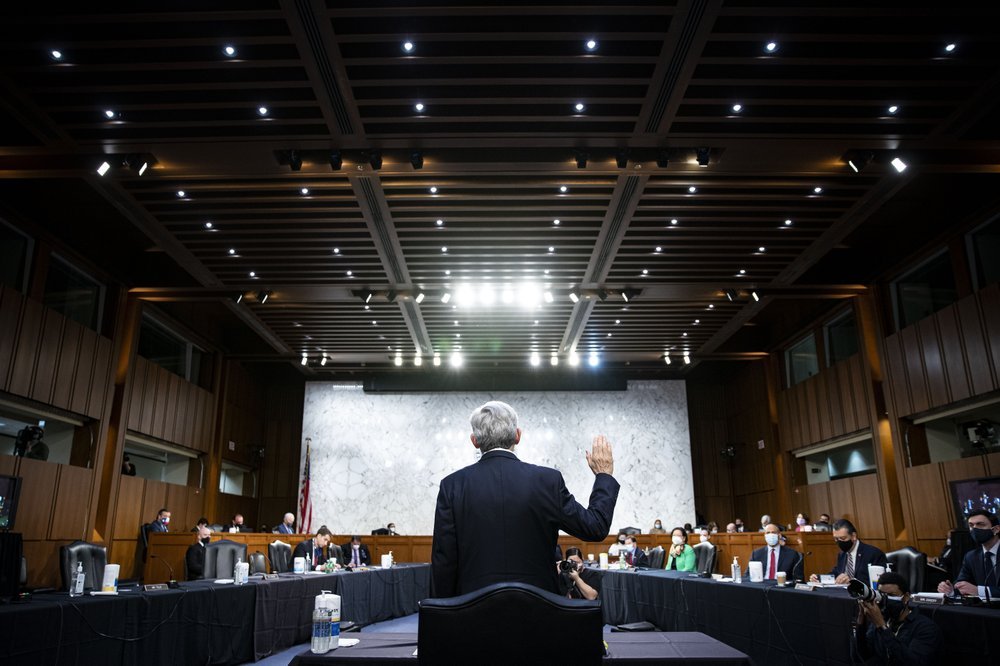Chapter Two
Photos
Photographs of people, places, and things mentioned in chapter two. The number on the left indicates the page on which the content of the photo is mentioned in the book. Many of the photos also link to additional material.
Page 48 -- The not very awe-inspiring headquarters of J.W. Hampton Jr. & Co. in Queens, NY, in business since 1865.
Page 50 -- NRA Blue Eagle. The blue eagle — holding a gear and lightning bolts in its talons — was the symbol of the National Recovery Administration. Prior to the Court's decision in Schechter, firms that adhered to a Code of Fair Competition posted the blue eagle sign. (The Philadelphia Eagles football team, established in 1933, was apparently named after the NRA Blue Eagle). The decision in Schechter doomed the eagle.

Page 50 -- New Deal political cartoon. An editorial cartoon from the 1930s celebrating the Supreme Court's holding the line against executive overreach in Schechter and other cases. Note the number of documents labelled "code" in the dismayed officials' pockets.

Page 50 -- From the Department of No Hard Feelings. The New York Times reports that despite their clash with New Deal excess, everyone in the Schechter clan voted for FDR in the subsequent presidential election.
Page 91 -- Jagdish Rai Chadha.
Page 91 -- Representative Joshua Eilberg (D-Pa). Eilberg chaired the Subcommittee on Immigration, Citizenship, and International Law of the House Judiciary Committee. It was he who convinced the House (or whatever members happened to be in the chamber at the time) to veto the AG's suspension of removal of Chadha and five others. His explanation, pretty much in full, was: "It was the feeling of the committee, after reviewing 340 cases, that the aliens contained in the resolution did not meet [the] statutory requirements, particularly as it relates to hardship; and it is the opinion of the committee that their deportation should not be suspended."
Page 104 -- Witnesses at an oversight hearing being sworn in before their testimony and questioning. Notice how absolutely delighted they all seem to be there.
Page 104 -- More keenly excited oversight hearing witnesses
Page 104 -- Congressman John Dingell, in his Chairman's seat, looking benign.

Page 124 -- Merrick Garland being sworn in before before appearing before the Judiciary Committee, which was considering his appointment as Attorney General. The Garland saga, including the fact that no such photograph exists in the context of his nomination to the Supreme Court, is a reminder of the potency of the Senate's power of advice and consent.

Page 131 -- A contemporary newspaper article about the firing of Frank Myers. By the time the case reached the Supreme Court, the "Myers" in the caption was not Frank but Lois, Frank's widow and the administratrix of his estate. Frank died in 1924, after losing in the Court of Claims and before the Supreme Court heard his case. Cf. Humphrey's Executor v. United States.
Page 132 -- This is, of course, President Franklin Delano Roosevelt. It seems unlikely that this is a photo of him actually penning his message firing William Humphrey, but who knows? -- anything is possible. The link will take you to a recording of FDR's remarks at the laying of the cornerstone for the FTC building on July 12, 1937.
Page 132 -- William Humphrey, FDR's least favorite FTC Commissioner. Humphrey was appointed by President Hoover in 1931; FDR purported to fire him on October 8, 1933; he died on February 14, 1933. The lawsuit filed by the executor of his estate sought four months of back pay.








